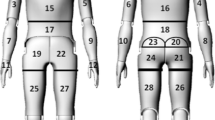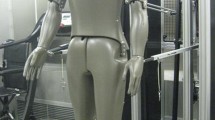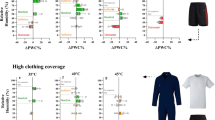Abstract
A meta-analysis of the effect of body and air movement on the insulation provided by workwear and cold-weather clothing [1.22 clo (0.189 m 2 °C W −1) <I T<4.14 clo (0.642 m 2 °C W −1)] using data from different sources was performed. For the effect of walking, datasets could be merged and a single prediction equation produced (r 2=0.91). For the effect of wind, and interaction of movement and wind, separate equations were required for regular workwear (r 2=0.93) and cold-weather clothing (r 2=0.97). Differences were mainly due to the different amounts of nude surface area. An interaction between wind and walking effects was present (the size of the combined effects is less than the sum of the separate effects), and for cold-weather clothing an effect of clothing air permeability (p) was present (high p→bigger effect). The resulting prediction equations will be proposed for inclusion in European and ISO standards on protective clothing to assist the user in determining the real-life clothing insulation value.


Similar content being viewed by others
References
Bouskill LM, Havenith G, Kuklane K, Parsons KC, Withey WR (2002) Relationship between clothing ventilation and thermal insulation. Am Ind Hyg Assoc J 63:262–268
Buxton A, Zhubrin S, Daanen H (2002) Implementation of clothing, microclimate and movement models for a virtual manikin. In: Proceedings of the 10th International Conference on Environmental Ergonomics, Fukuoka, Japan, 23-27 September 2002, pp 431–434
Havenith G, Heus R, Lotens WA (1990a) Resultant clothing insulation: a function of body movement, posture, wind, clothing fit and ensemble thickness. Ergonomics 33:67–84
Havenith G, Heus R, Lotens WA (1990b) Clothing ventilation, vapour resistance and permeability index: changes due to posture, movement and wind. Ergonomics 33:989–1005
Havenith G, Holmér I, Parsons KC (2002) Personal factors in thermal comfort assessment: clothing properties and metabolic heat production. Energy Buildings 34:581–591
Holmér I, Nilsson H, Havenith G, Parsons KC (1999) Clothing convective heat exchange—proposal for improved prediction in standards and models. Ann Occup Hyg 43:329–337
International Organization for Standardization (1994) Moderate thermal environments—determination of the PMV and PPD indices and specification of the conditions for thermal comfort. ISO 7730. International Organization for Standardization, Geneva
International Organization for Standardization (1995) Ergonomics of the thermal environment—estimation of the thermal insulation and evaporative resistance of a clothing ensemble. ISO 9920. International Organization for Standardization, Geneva
International Organization for Standardization (1997) Hot environments—analytical determination and interpretation of thermal stress using calculation of required sweat rate. ISO 7933. International Organization for Standardization, Geneva
International Organization for Standardization (1999) Evaluation of cold environments—determination of required clothing insulation (IREQ). ISO/TR 11079. International Organization for Standardization, Geneva
Kim CS, McCullough EA (2000) Static and dynamic insulation values for cold-weather protective clothing. In: Nelson CN, Henry NW (eds) Performance of protective clothing: issues and priorities for the 21st century, vol 7. ASTM STP 1386. American Society for the Testing of Materials, Conshohocken, Pa., pp 233–247
Nielsen R, Olesen BW, Fanger PO (1965) Effect of physical activity and air velocity on the thermal insulation of clothing. Ergonomics 28:1617–1632
Nilsson HO (1997) Analysis of two methods of calculating the total insulation. In: Proceedings of a European Seminar on Thermal Manikin Testing (1IMM), Department of Ergonomics, Arbetslivsinstitutet, Solna, pp 17–22
Nilsson HO, Holmér I (1997) Development and clothing measurements methods with the thermal manikin TORE. In: Proceedings of the 5th Scandinavian Symposium on Protective Clothing, Danish Work Environment Fund, Elsinore, pp 30–35
Nilsson HO, Anttonen H, Holmér I (2000) New algorithms for prediction of wind effects on cold protective clothing. In: 1st European Conference on Protective Clothing. Arbete och Hälsa 8, Stockholm, pp17–20
Olesen BW, Madsen TL (1983) Measurements of the thermal insulation of clothing by a movable manikin. In: International Congress of Medical and Biophysical Aspects of Protective Clothing, Lyon, July 1983
Author information
Authors and Affiliations
Corresponding author
Additional information
An erratum to this article can be found at http://dx.doi.org/10.1007/s00421-004-1267-2
Rights and permissions
About this article
Cite this article
Havenith, G., Nilsson, H.O. Correction of clothing insulation for movement and wind effects, a meta-analysis. Eur J Appl Physiol 92, 636–640 (2004). https://doi.org/10.1007/s00421-004-1113-6
Published:
Issue Date:
DOI: https://doi.org/10.1007/s00421-004-1113-6




